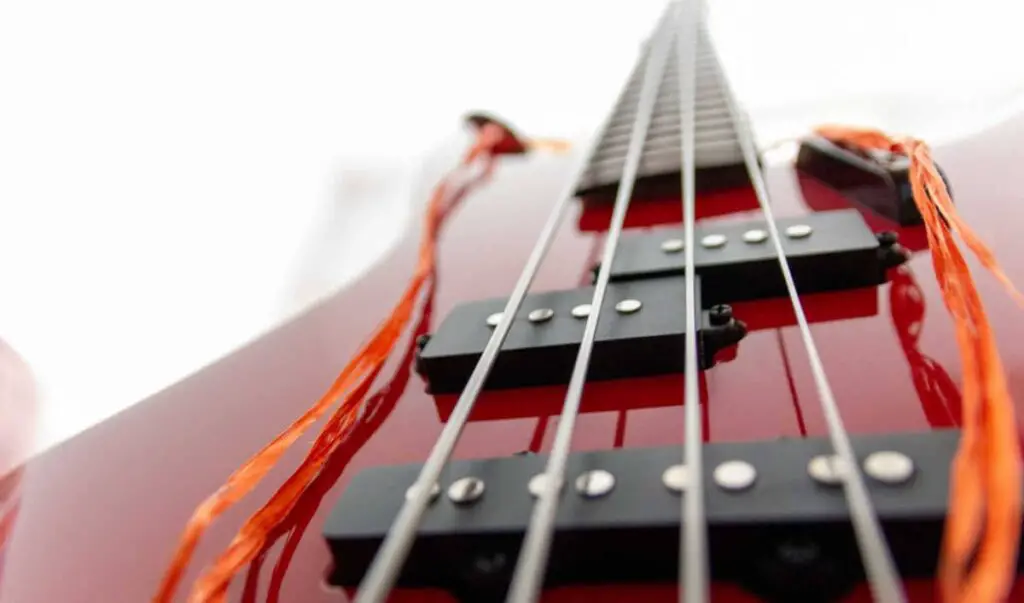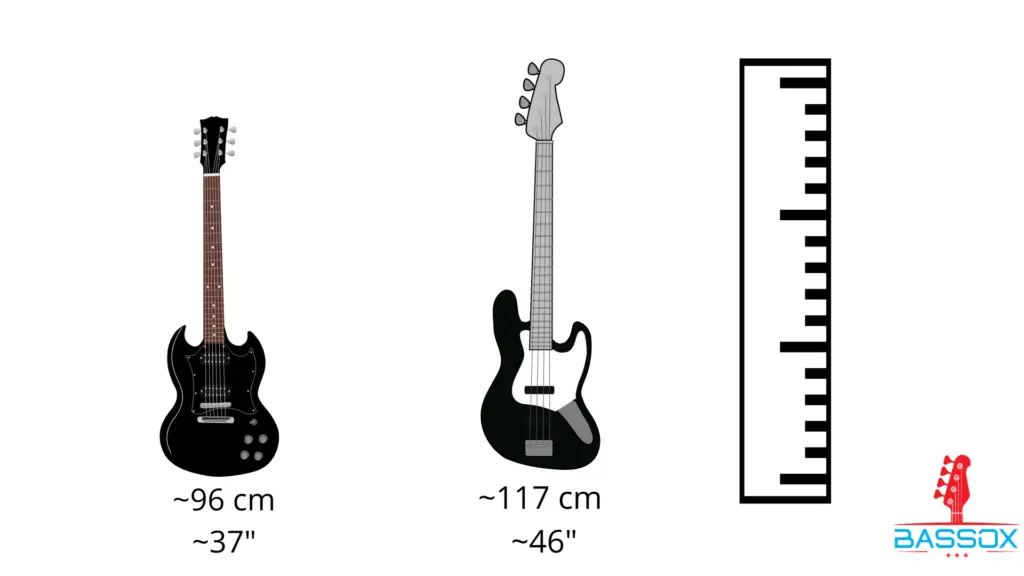I started playing bass 14 years ago because I was immediately drawn to both the sound and look of it. Becoming a bassist seemed like a no-brainer, as the bass looked and sounded bigger than the guitar. It`s only recently that I got around to asking why this is. So, why are basses so long?
Basses are so long due to being a string instrument that is played at deeper frequencies. The bass guitar needs thick strings that get enough room to vibrate in order to produce its signature deep sound. This would not be possible without having a long neck.
So if the basses weren’t as long as they commonly are, this would cause one out of two issues. They would either not be able to be played low enough, or they would need even thicker strings.
But why don’t we just play guitar-sized basses with thicker strings, and why are some basses different sizes than others? Turns out, there is more to bass guitar size than “Deep sound = Big instrument”.
Why are basses bigger than guitars?
Since basses are tuned lower than guitars they need to be longer due to their thicker strings. Thicker and longer strings allow the bass to be played at deeper frequencies. If a bass was the size of a guitar, the strings would need to be even thicker.
One of the key differences between guitars and basses is their tuning. Both are tuned to E standard, but the lowest E on a standard guitar is tuned an octave higher than the lowest E on a standard bass.
While they share some similarities, the dimensions of a bass are therefore different from that of a guitar. Full-size electric guitars have a scale length of about 25.5″, or 64.8cm. Bass guitars on the other hand, most commonly have a scale length of 34″, or 83.4cm.
In order to understand why basses are bigger than guitars, we need to understand what makes a string instrument deeper. There are 3 things that can be done to a string to deepen its frequency:
- Increase the mass of it
- Increase the length of it
- Lower the tension of it
The tension of a string can only be changed a couple of whole steps before it starts to greatly affect playability. Thus, basses rely on strings that are thick and long enough to get their deep sound.
Thus, basses would either need thicker or looser strings if they were the size of a standard guitar. Both of these options would affect playability negatively.

What if basses were shorter?
Short-scale basses are basses with a scale length of at least 3″, or 8cm, less than that of a standard bass. These basses are tuned the same way as standard basses but have a different string thickness and tension to allow for a shorter neck.
While a shorter bass requires thicker strings and less tension than a standard bass, many bassists have preferred the playability of short-scare basses.
These basses are also often preferred by bassists with smaller hands and are generally praised for having a richer tone. Here are some of the most famous bassists that played shorter basses:
- Paul McCartney (The Beatles)
- Bill Wyman (Rolling Stones)
- Jack Bruce (Cream)
- Tina Weymouth (Talking Heads)
- Glenn Cornick (Jethro Tull)
There are also several other string instruments that exist between the size of the standard bass and standard guitar.
Bass IVs and Baritone Guitars both generally have a scale length between 27″ and 30″, or 69mm and 77mm. Bass IVs are 6-string basses tuned like a guitar 1 octave lower. Baritone Guitars are slightly larger guitars that are tuned a 4th or 5th below standard guitar tuning.
Related reading: Why do basses have 4-strings?
How long is the scale on a bass guitar?
A standard 4-string bass has a scale length of 34″, or 86cm and most modern bass guitars are this long. 5 and 6-string basses also tend to be slightly shorter than 4-string basses. Short-scale basses exist at 31″, or 79cm, and below. Extra long-scale basses exist at 36′”, or 91cm, and up.
Scale length is a common way to measure the length of an instrument. However, it is not the same as the full size of your bass or the length of your neck. Here is how to measure bass guitar scale length correctly:
The distance from the nut to the bridge on a bass is the scale length on a bass. Thus, measure the length of your strings from where they are seated between the neck and head to where they are seated at the bottom of the body.
Related reading: The complete guide to nut height
Scale length is a common measurement among all string instruments, including violins, double basses, ukuleles, and Mandolins. It thus serves as a great way to understand how stringed instruments work in relation to one another.

What is the total length of a bass guitar?
When measured from the bottom of the body to the top of the head, a standard-sized 4-string bass guitar is 46″ or 117cm in total length.
Basses are commonly measured in scale length and rarely in total length. If you read or hear musicians talking about 34″ bass guitars, they are talking about the scale length.
The total length works as a great measurement for certain things though, such as:
- Whether your bass fits in a case or bag
- Whether a child has grown big enough to play the bass
- How you can pack your bass when traveling

Conclusion
Basses need to be long in order to accommodate long, thick strings with tight tension. This is necessary to play at the deep frequencies that the bass was built for.
Leo Fender popularized the bass guitar in the 1950s with the Fender P-bass, which had a scale length of 34″. This has remained the norm for the majority of basses since then.
Bass guitars can sound great, and many bassists have argued that they even sound better, at slightly shorter lengths. Due to the bass being a large instrument in the first place, smaller basses also make a lot more sense to some due to their physiology.
34″ is the standard, and it has always suited me well personally. Still, a large reason for this being the standard is happenstance and the Fender P-bass defining what the bass guitar became.

